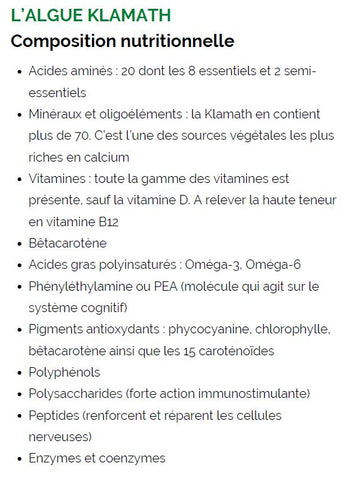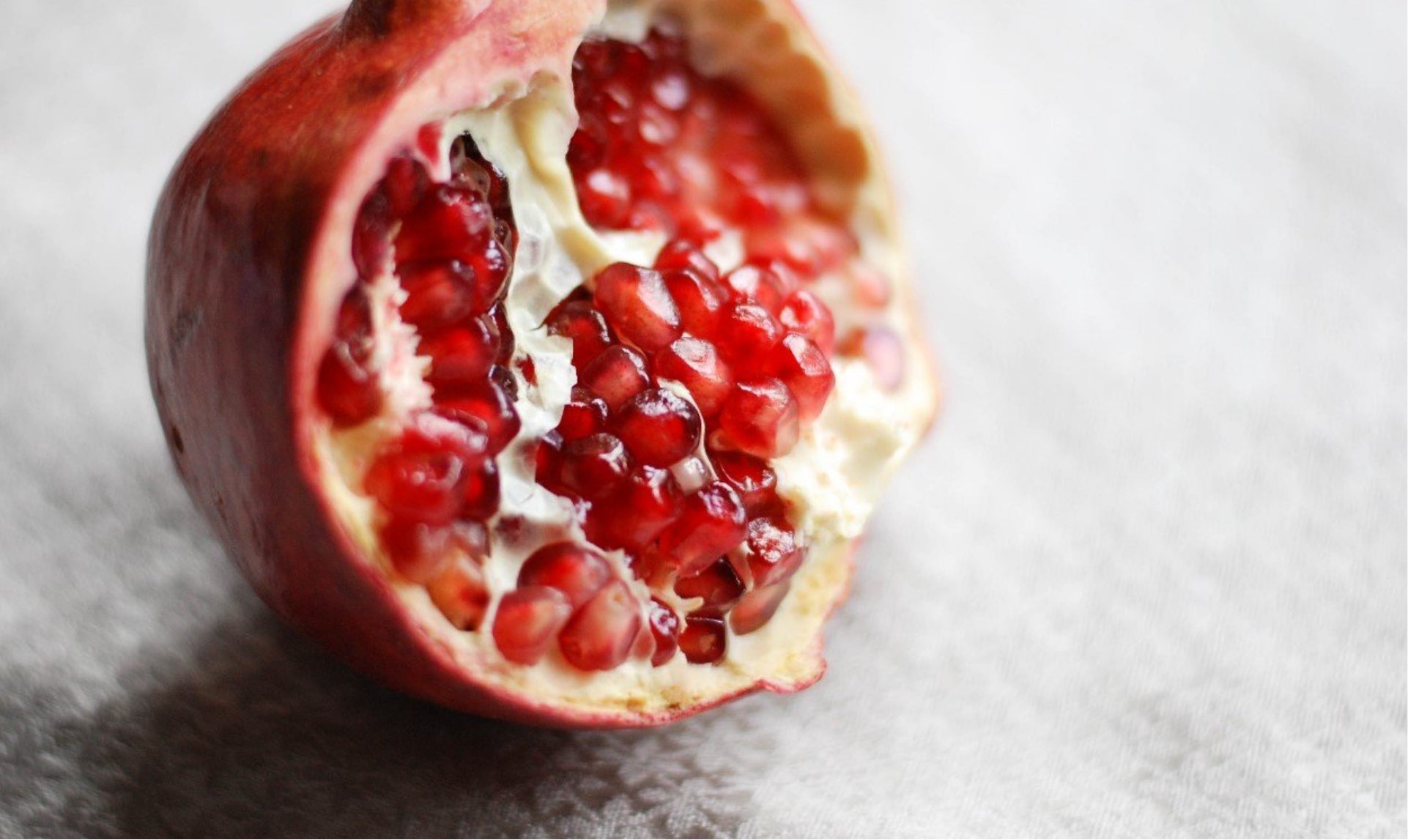
12/10/2020
Coup de projecteur sur la reine des algues : la Klamath
Aux Etats-Unis, dans le sud de l’Oregon, coule un lac d’altitude à l’abri de toute pollution, le Lac Upper Klamath. Dans ce biotope exceptionnel s’y développe depuis des millénaires une petite merveille de la nature : l’Aphanizomenon Flos-Aquae (AFA) ou algue Klamath. Considérée par les chercheurs comme l’aliment le plus complet au monde, cette micro-algue possède plus de 115 micronutriments hautement assimilables. Fortifiante, revitalisante et reconstituante, la Klamath contient des principes actifs spécifiques faisant d’elle une algue inégalée.
Les origines de la Klamath
L’algue Klamath est l’une des plus anciennes formes de vie apparue sur notre planète. Elle a traversé toutes les époques, résistant aux microbes et à la pollution. Consommée depuis des milliers d’années par la tribu des Klamaths, un peuple d’amérindiens de l’Oregon, cette micro-algue fut découverte dans les années 1970, puis commercialisée comme compléments alimentaires aux États-Unis en 1980. Il a fallu attendre le milieu des années 1990 pour que les études scientifiques américaines viennent confirmer ses bienfaits. Depuis 2000, de nombreuses recherches sont menées en Europe, et notamment à l’Université d’Urbino en Italie. Popularisée dans le monde entier, la Klamath est aujourd’hui consommée en complément alimentaire, en gélules, en comprimés, en paillettes ou en poudre.
Une composition unique
Les vertus nutritives et thérapeutiques de l’algue Klamath furent mentionnées pour la première fois par Cortès, dans son journal de bord des conquêtes espagnoles du XVIe siècle. Avec ses 115 nutriments, la Klamath se démarque par la richesse de ses composants : acides aminés, acides gras essentiels, vitamines, minéraux, oligoéléments, glucides complexes, pigments antioxydants, polyphénols, ou encore enzymes.
Phycocyanine et Phényléthylamine : les principaux actifs
La Klamath contient deux antioxydants particulièrement puissants qui la rendent unique. Ce sont la phycocyanine et la phényléthylamine. La phycocyanine, pigment bleu-vert qui colore la Klamath, est un puissant antioxydant qui empêche l’oxydation de l’ADN et régénère les tissus. La phényléthylamine (PEA) est une hormone produite dans le cerveau qui stimule la libération de dopamine, un neurotransmetteur agissant sur le système nerveux central comme un « antidépresseur » naturel. La PEA permet également d’augmenter la vigilance et la concentration.
Klamath, Spiruline et Chlorella : la championne est...
Consœurs de la Spiruline et de la Chlorella, la Klamath est une algue encore plus riche en nutriments. Elle contient en effet des principes actifs spécifiques que les autres n’ont pas.
- 3 oligoéléments : l’iode (indispensable au bon fonctionnement de la thyroïde), le bore (diurétique), le molybdène (participe à la fixation du fer)
- La phényléthylamine (PEA)
- Des acides aminés aux propriétés photoprotectrices contre les UVA-UVB
- Des enzymes végétales qui stimulent les enzymes pancréatiques et facilitent la digestion
En raison de sa récente découverte, l’algue Klamath fait l’objet de moins d’études cliniques que pour la Spiruline et la Chlorella. Cependant, elle confirme son intérêt dans la prise en charge d’un certain nombre de pathologies.
Propriétés et bienfaits de la Klamath
La composition exceptionnelle de la Klamath en fait un super aliment de premier choix, en prévention et comme soutien de l’organisme.
Vertus antioxydantes
Riche en polyphénols, caroténoïdes, chlorophylle et vitamine C, l’algue Klamath a un pouvoir antioxydant puissant et permet de lutter contre le vieillissement cellulaire. Ses acides aminés aux propriétés anti-radicalaires protègent également les cellules des UVA et UVB. La micro-algue agit ainsi efficacement contre le stress oxydatif occasionné par l’excès de radicaux libres dans l’organisme.
Stimule le système immunitaire
Les polysaccharides contenus en grande quantité dans l’algue Klamath possèdent des agents actifs qui activent les globules blancs. Ces derniers sont responsables de détecter et de détruire les cellules dégénérées ou infectées par les virus. Le système immunitaire se défend alors plus facilement et plus rapidement, évitant ainsi les infections virales et freinant le développement de certaines pathologies.
Un antidépresseur naturel
Les chercheurs américains ont découvert dans l’algue Klamath une concentration significative de phényléthylamine (PEA). La PEA est une substance produite par le cerveau, nommée familièrement « molécule de l’amour » ou « molécule de la joie », à l’origine de la libération d’adrénaline et de dopamine. Cette molécule stimule les centres du plaisir agissant ainsi sur l’humeur, la joie et le bien-être émotionnel.
Stimule la concentration
La PEA dynamise également l’activité cérébrale et les capacités intellectuelles. Elle améliore l’intuition, la capacité de concentration, la mémoire, l’énergie et la résistance physique et mentale. Les études ont montré chez les enfants une diminution des troubles du comportement, tels que l’hyperactivité, le stress à l’école ou la dyslexie.
Favorise la production de cellules souches
Une des grandes forces de la Klamath est qu’elle stimule la production de nos propres cellules souches. Ces cellules sont capables de réparer les organes ou les tissus abîmés en se multipliant indéfiniment. Avec l’âge et le stress oxydatif, ce renouvellement diminue. La Klamath favorise la production de ces cellules et soutient la régénération des organes et des tissus.
Détoxine l’organisme
L’algue Klamath contient des antioxydants qui protègent notre corps contre les métaux lourds, les métaux radioactifs, les pesticides et les herbicides. Les polysaccharides, la chlorophylle et la phycocianine sont en effet trois molécules qui s’occupent de détecter les métaux dans les tissus et les organes, de les capter puis de les éliminer par les reins, contrairement à d’autres algues vertes comme la Chlorella qui se limite à attraper les métaux lourds sans toutefois les éliminer.
Prévient les carences
La concentration exceptionnelle de la Klamath en protéines, fer, acides aminés et oligoéléments, ainsi que sa richesse en vitamine B12 fait de cette algue un aliment très apprécié des personnes aux régimes végétariens et végétaliens. Elle comble entre autres les carences en protéines, fer, et vitamine B12.

La Klamath : pour qui ?
L’algue Klamath peut être consommée par tous. Sa richesse en nutriments convient parfaitement aux personnes âgées, aux sportifs, aux étudiants, aux femmes enceintes ou ménopausées, aux convalescents, aux végétariens carencés, aux personnes dénutries ou dont les besoins en protéines sont augmentés, ou lors de fatigue chronique. Grâce à la phycocyanine, la Klamath est également préconisée aux personnes souffrant d’arthrose ou de problèmes inflammatoires. Elle est aussi conseillée durant les changements de saison, afin de renforcer le système immunitaire. Bref, l’algue Klamath peut être consommée pour ses effets nutritifs ou ses effets curatifs.
Comment la consommer ?
L’algue Klamath est disponible sous forme de poudre, de comprimés, de paillettes ou de liquide, mais on la trouve le plus fréquemment en gélules. En cuisine, l’algue bleue s’intègre aussi bien à des préparations sucrées que salées. En été, on peut facilement l’apprêter en smoothies, comme par exemple celui à l’Epinard, Klamath et Poire. Mais le goût prononcé de l’algue en poudre ne convient pas à tout le monde. Dans ce cas, privilégiez la Klamath sous forme de compléments alimentaires.



